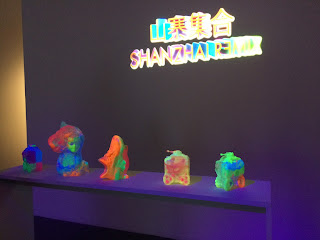 |
| The entrance of the exhibit, displaying fluorescent sculptures below. |
On May 18, I visited the “Delete Me” DESMA MFA Exhibition. Upon entering the exhibition, I was immediately in awe of all the beautiful exhibits. Eventually, I found my way to an exhibit that had fluorescent sculptures with projected images onto two walls. I read the title of the exhibit, which said “SHANZHAI REMIX” and displayed several Chinese characters. After using Google Translate to translate the characters into English, I discovered that this phrase meant “copycat.” Now knowing this, I looked around and thought that this artist’s exhibit shows viewers the different copies of her original fluorescent sculptures because the projected images displayed those same figures but in different representations. Interested to learn more about the meaning behind this exhibit and whether my thought process was on the right track, I talked to the artist, Yuehao Jiang.
 |
| The first wall of projected images, showing copycats of the fluorescent sculptures. |
 |
| A zoomed-in image displaying specifically how the fluorescent sculptures such as the shoe and the girl are altered in different manners. |
Jiang said that the purpose of this exhibit was to show viewers the copycat culture and the importance of intellectual property in the world we live in. Originally from China, Jiang witnessed firsthand that Chinese companies copy many products from around the world and re-sell these products at a cheaper cost. As a result, Chinese consumers may not know the culture behind specific images that they find on products such as T-shirts, stuffed animals, or toys. For instance, in America, we recognize the yellow, animated minions from the movie, Despicable Me. However, in China, some companies sell products with the image of a minion with slight distortions. Chinese consumers may not recognize these minions as the lovable characters from the Despicable Me, but instead, just see a cute figure on an affordable product. These consumers only know the image, but not the full story, robbing the meaning behind the original minion. This then robs the creators of the minions from Despicable Me credit where it’s due, showing the problem of intellectual property theft in this day and age.
Impressed by this intricate back-story for the purpose of this exhibit, I then discussed with Jiang my interpretation on the use of her art pieces to bring about that this copycat theme. With my ideas in the right direction, she explained that the sculptures and the images on the wall were her own copycats. With the original being the product that she was inspired by, the sculptures were copycats because they were 3D-printed pieces based off of the original product. The computer-designed graphics on the walls were copycats of the 3D-printed sculptures, displaying a second generation of copycats. Then, on the screens on the other wall, she displayed fake products that Chinese websites were selling and overlapped these products with a her own 3D-model of that product, showing another second generation of copycats, where the Chinese company was the first copycat and Jiang’s model is the second copycat.
 |
| The second wall of projected images, showing the copycat Chinese product as the background of each screen, with Jiang's 3D-model of this copycat product. |
 |
| One of the copycat screens showing how a flying toy was copycat of two generations now. |
This exhibition was my first DESMA graduate exhibition, and I loved it. I highly recommend that everyone take time out of their week to see what these students are working on. Artists such as Jiang, who specializes in computer graphics and programming, communicate their views on life through these spectacular works of art, conveying deeper meanings that all of us should consider. Before this exhibit, I have heard about this copycat culture, but I never realized the negative ramifications of this culture. Now, I will make a conscious effort to look for intellectual property theft and encourage others to do the same.
 |
| Proof of Attendance: Picture of myself as well as a classmate (left), Sarah Chin, and the artist (middle), Yuehao Jiang. |


















